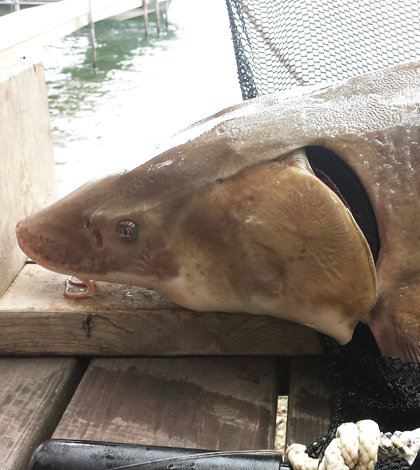Buffalo State scientists investigate resurging lower Niagara lake sturgeon

A lake sturgeon is measured after being tagged with an acoustic transmitter, and then released back into the Niagara River. (Credit: Erik Bruestle)
In the lower Niagara River, threatened populations of lake sturgeon are making a comeback and officials with the U.S. Fish and Wildlife Service want to know why. To get at the answer, The Niagara Greenway Ecological Fund has funded a study to investigate the rebound with the work being conducted by SUNY Buffalo State and the U.S. Fish and Wildlife Service. The nearly complete research has found important food sources for the fish, as well as indicators that the area overall may be getting a little healthier.
Knut Mehler, a research scientist at Buffalo State University’s Great Lakes Center heads up the study that has utilized river substrate maps, PONAR grab samplers and side-scan sonar in making some interesting findings. Results of the investigation will prove important to better managing the lake sturgeon stock in the lower Niagara, as well as provide insights into the health of an important Great Lakes tributary.
“This work is in collaboration with the U.S. Fish and Wildlife Service, which did the sonar survey in 2011,” said Mehler. “We used data from them to create benthic habitat maps for the lower Niagara River.”
With those preliminary maps in hand, it was clear that the river’s dominant substrate is bedrock, gravel and sandy substrate. Toward the shoreline, says Mehler, there are finer substrates such as silty sand there. And through figuring out the different substrates in the lower Niagara River, he was able to move on to studying which invertebrates species thrive in each setting.

Knut Mehler records observations during extensive benthic sampling on the lower Niagara River. (Credit: Eric Bruestle)
Mehler used a PONAR grab sampler to collect sediment samples across 147 points of the river and lab analysis helped reveal the invertebrates that seemed to gravitate toward different substrate materials. This is important because benthic invertebrate communities are indicators of the sediment and water quality, and there are major food sources for fish, including lake sturgeon.
“The Fish and Wildlife Service tagged many sturgeon in the lower Niagara,” said Mehler. “But there were three sites where lake sturgeon was captured more frequently than in any other areas.”
And so by confirming what sort of invertebrates live in those zones, both Mehler and researchers with the U.S. Fish and Wildlife Service can begin to understand the food sources that sturgeon are using for survival. That knowledge can then be integrated into recovery plans and other efforts looking to save the fish.
“In previous research, in soft substrates like silt and sand, we’ve mostly found segmented worms (Oligochatea) and non-biting midges (Chironomids). Hard substrates were mostly covered with Dreissenid mussels,” said Mehler. “Our sampling confirmed those communities.” In the substrates with smaller sediment grains overall, says Mehler, there were typically higher Oligochaeta and Chironomid biomass in quantities much greater than were found in gravelly areas.
Those findings will be paired with a sturgeon stomach content analysis currently being carried out by Eric Bruestle, a graduate student studying Great Lakes ecosystem science. And though they are preliminary, Bruestle does have some findings to report: lake sturgeon appear to be feeding on invasive species for much of their diet, chomping down predominantly on round gobies and amphipods, a shrimp-like crustacean.
Once all the data have been gathered, Mehler plans to present his findings at the upcoming meeting of the International Association for Great Lakes Research in May 2015. Results will also be shared with the U.S. Fish and Wildlife Service.
“In another study we are planning to compare our recent data on the benthic community with historical data that were collected 30 years ago to see if the improvements in water quality can be seen in the benthic communities we found,” said Mehler.
Top image: A lake sturgeon is measured after being tagged with an acoustic transmitter, and then released back into the Niagara River. (Credit: Eric Bruestle)




0 comments